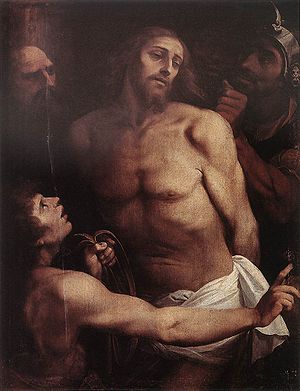
Giuseppe Cesari
Encyclopedia

Italy
Italy , officially the Italian Republic languages]] under the European Charter for Regional or Minority Languages. In each of these, Italy's official name is as follows:;;;;;;;;), is a unitary parliamentary republic in South-Central Europe. To the north it borders France, Switzerland, Austria and...
Mannerist
Mannerism
Mannerism is a period of European art that emerged from the later years of the Italian High Renaissance around 1520. It lasted until about 1580 in Italy, when a more Baroque style began to replace it, but Northern Mannerism continued into the early 17th century throughout much of Europe...
painter
Painting
Painting is the practice of applying paint, pigment, color or other medium to a surface . The application of the medium is commonly applied to the base with a brush but other objects can be used. In art, the term painting describes both the act and the result of the action. However, painting is...
, also named Il Giuseppino and called Cavaliere d'Arpino, because he was created Cavaliere di Cristo by his patron Pope Clement VIII
Pope Clement VIII
Pope Clement VIII , born Ippolito Aldobrandini, was Pope from 30 January 1592 to 3 March 1605.-Cardinal:...
. He was much patronized in Rome
Rome
Rome is the capital of Italy and the country's largest and most populated city and comune, with over 2.7 million residents in . The city is located in the central-western portion of the Italian Peninsula, on the Tiber River within the Lazio region of Italy.Rome's history spans two and a half...
by both Sixtus V.
Biography
Cesari's father had been a native of ArpinoArpino
Arpino is a comune in the province of Frosinone in the region of Latium in central Italy. Its Roman name was Arpinum.-History:...
, but Giuseppe himself was born in Rome. Here, he was apprenticed to Niccolò Pomarancio. Cesari is stigmatized by Lanzi
Luigi Lanzi
Luigi Lanzi was an Italian art historian and archaeologist.Born in Treia, Lanzi was educated as a priest. He entered the Order of the Jesuits, resided at Rome and in 1773 was appointed keeper of the galleries of Florence, where he became president of the Accademia della Crusca...
, as not less the corrupter of taste in painting than Marino was in poetry. (Lanzi disdained the style of post-Michelangelo Mannerism
Mannerism
Mannerism is a period of European art that emerged from the later years of the Italian High Renaissance around 1520. It lasted until about 1580 in Italy, when a more Baroque style began to replace it, but Northern Mannerism continued into the early 17th century throughout much of Europe...
as a time of decline).
He was a man of touchy and irascible character, and rose from penury to the height of opulence. His brother Bernardino Cesari
Bernardino Cesari
Bernardino Cesari was an Italian painter of the late-Mannerist and early Baroque period, active mainly in Rome and Naples, where he assisted his brother Giuseppe Cesari ....
assisted in many of his works.
Cesari became a member of the Accademia di San Luca
Accademia di San Luca
The Accademia di San Luca, was founded in 1577 as an association of artists in Rome, under the directorship of Federico Zuccari, with the purpose of elevating the work of "artists", which included painters, sculptors and architects, above that of mere craftsmen. Other founders included Girolamo...
in 1585. In 1607, he was briefly jailed by the new papal administration. He died in 1640, at the age of seventy-two, or perhaps of eighty, at Rome.
His only direct followers were his sons Muzio (1619–1676) and Bernardino (d. 1703). Pier Francesco Mola
Pier Francesco Mola
Pier Francesco Mola was an Italian painter of the High Baroque, mainly active around Rome.-Biography:Mola was born at Coldrerio . At the age of four, he moved to Rome with his father Giovanni Battista, a painter...
(1612–66) apprenticed in his studio. Other pupils include Francesco Allegrini da Gubbio
Francesco Allegrini da Gubbio
Francesco Allegrini da Gubbio was an Italian painter of the Baroque period.Born in Gubbio, he was also called Francesco da Gubbio. His father, Flaminio Allegrini da Cantiano, was also a painter. He studied under Giuseppe Cesari , and later was helped by his sons in painting historical and...
, Guido Ubaldo Abatini, Vincenzo Manenti
Vincenzo Manenti
Vincenzo Manenti was an Italian painter of the Baroque period.He was born and active in Canimorto in the province of Sabina. where he had been first a pupil of his father, Ascanio Manenti, but then apprenticed with Giuseppe Cesari and Domenichino. He painted a St. Stefano for the cathedral at...
, and Bernardino Parasole
Bernardino Parasole
Bernardino Parasole was an Italian painter of the Baroque period.He was born to the painters, Isabella and Leonardo Parasole, but then apprenticed with Giuseppe Cesari. Bernardino died young.-References:...
.
His most notable and perhaps surprising pupil was Caravaggio. In c. 1593-94, Caravaggio held a job at Cesari's studio as a painter of flowers and fruit.
Selected works
- Cappella Olgiati in Santa PrassedeSanta PrassedeThe Basilica of Saint Praxedes , commonly known in Italian as Santa Prassede, is an ancient titular church and minor basilica in Rome, Italy, located near the papal basilica of Saint Mary Major...
(1592) - Frescoes in Salon of the Palazzo dei Conservatori (now Capitoline Museum, 1595-56)
- Battle between Horatii and Curiatiihttp://www.museicapitolini.org/scripts/scheda.asp?lingua=en&id=S_OraziB1
- Finding of the She-wolfhttp://www.museicapitolini.org/scripts/scheda.asp?lingua=en&id=S_OraziC
- Rape of the Sabine Womenhttp://www.museicapitolini.org/scripts/scheda.asp?lingua=en&id=S_OraziA
- Numa Pompilius Instituting the Cult of the Vestalshttp://www.museicapitolini.org/scripts/scheda.asp?lingua=en&id=S_OraziD2
- Cappella Paolina in the church of Santa Maria Maggiore (1609)
External links
- Biography at arte-argomenti.org

